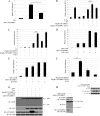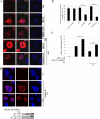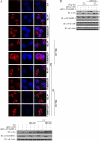An RNA interference screen identifies the Deubiquitinase STAMBPL1 as a critical regulator of human T-cell leukemia virus type 1 tax nuclear export and NF-κB activation
- PMID: 22258247
- PMCID: PMC3302326
- DOI: 10.1128/JVI.06456-11
An RNA interference screen identifies the Deubiquitinase STAMBPL1 as a critical regulator of human T-cell leukemia virus type 1 tax nuclear export and NF-κB activation
Erratum in
- J Virol. 2012 May;86(9):5409
Abstract
The human T-cell leukemia virus type 1 (HTLV-1) Tax oncoprotein actively shuttles between the nucleus, where it interacts with transcriptional and splicing regulatory proteins, and the cytoplasm, where it activates NF-κB. Posttranslational modifications of Tax such as ubiquitination regulate its subcellular localization and hence its function; however, the regulation of Tax trafficking and NF-κB activation by host factors is poorly understood. By screening a deubiquitinating (DUB) enzyme small interfering RNA (siRNA) library, we identified the metalloprotease STAM-binding protein-like 1 (STAMBPL1) as a positive regulator of Tax-mediated NF-κB activation. Overexpression of wild-type STAMBPL1, but not a catalytically inactive mutant, enhanced Tax-mediated NF-κB activation, whereas silencing of STAMBPL1 with siRNA impaired Tax activation of both the canonical and noncanonical NF-κB signaling pathways. STAMBPL1 regulated Tax-induced NF-κB signaling indirectly by controlling Tax nuclear/cytoplasmic transport and was required for DNA damage-induced Tax nuclear export. Together, these results reveal that the deubiquitinase STAMBPL1 is a key regulator of Tax trafficking and function.
Figures







Similar articles
-
HSP90 protects the human T-cell leukemia virus type 1 (HTLV-1) tax oncoprotein from proteasomal degradation to support NF-κB activation and HTLV-1 replication.J Virol. 2013 Dec;87(24):13640-54. doi: 10.1128/JVI.02006-13. Epub 2013 Oct 9. J Virol. 2013. PMID: 24109220 Free PMC article.
-
A non-SUMOylated tax protein is still functional for NF-κB pathway activation.J Virol. 2014 Sep;88(18):10655-61. doi: 10.1128/JVI.01827-14. Epub 2014 Jul 2. J Virol. 2014. PMID: 24991007 Free PMC article.
-
Ubiquitin-specific peptidase 20 targets TRAF6 and human T cell leukemia virus type 1 tax to negatively regulate NF-kappaB signaling.J Virol. 2011 Jul;85(13):6212-9. doi: 10.1128/JVI.00079-11. Epub 2011 Apr 27. J Virol. 2011. PMID: 21525354 Free PMC article.
-
Move or die: the fate of the Tax oncoprotein of HTLV-1.Viruses. 2011 Jun;3(6):829-57. doi: 10.3390/v3060829. Epub 2011 Jun 15. Viruses. 2011. PMID: 21994756 Free PMC article. Review.
-
Regulation of HTLV-1 tax stability, cellular trafficking and NF-κB activation by the ubiquitin-proteasome pathway.Viruses. 2014 Oct 23;6(10):3925-43. doi: 10.3390/v6103925. Viruses. 2014. PMID: 25341660 Free PMC article. Review.
Cited by
-
Honokiol Enhances TRAIL-Mediated Apoptosis through STAMBPL1-Induced Survivin and c-FLIP Degradation.Biomolecules. 2019 Dec 6;9(12):838. doi: 10.3390/biom9120838. Biomolecules. 2019. PMID: 31817770 Free PMC article.
-
Interference of HTLV-1 Tax Protein with Cell Polarity Regulators: Defining the Subcellular Localization of the Tax-DLG1 Interaction.Viruses. 2017 Nov 23;9(12):355. doi: 10.3390/v9120355. Viruses. 2017. PMID: 29168728 Free PMC article.
-
Low nuclear body formation and tax SUMOylation do not prevent NF-kappaB promoter activation.Retrovirology. 2012 Sep 25;9:77. doi: 10.1186/1742-4690-9-77. Retrovirology. 2012. PMID: 23009398 Free PMC article.
-
HSP90 protects the human T-cell leukemia virus type 1 (HTLV-1) tax oncoprotein from proteasomal degradation to support NF-κB activation and HTLV-1 replication.J Virol. 2013 Dec;87(24):13640-54. doi: 10.1128/JVI.02006-13. Epub 2013 Oct 9. J Virol. 2013. PMID: 24109220 Free PMC article.
-
A critical role for IL-17RB signaling in HTLV-1 tax-induced NF-κB activation and T-cell transformation.PLoS Pathog. 2014 Oct 23;10(10):e1004418. doi: 10.1371/journal.ppat.1004418. eCollection 2014 Oct. PLoS Pathog. 2014. PMID: 25340344 Free PMC article.
References
-
- Alefantis T, Barmak K, Harhaj EW, Grant C, Wigdahl B. 2003. Characterization of a nuclear export signal within the human T cell leukemia virus type I transactivator protein Tax. J. Biol. Chem. 278:21814–21822 - PubMed
-
- Alefantis T, et al. 2005. Secretion of the human T cell leukemia virus type I transactivator protein tax. J. Biol. Chem. 280:17353–17362 - PubMed
Publication types
MeSH terms
Substances
Grants and funding
LinkOut - more resources
Full Text Sources
Research Materials

